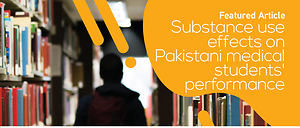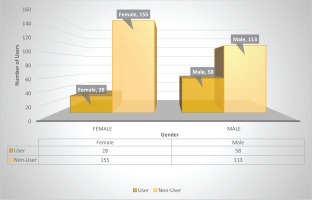INTRODUCTION
According to the World Health Organization, a psychoactive substance is any chemical substance which alters physical and/or mental function1. According to the Diagnostic and Statistical Manual of Mental Disorders, Fifth Edition (DSM-5), substance abuse is defined as the use of any drug, in a manner that deviates from approved social or medical patterns.
Drug abuse is a serious problem that has affected almost every part of the world, including developed countries. Around 5% of the global adult population reports using at least one illegal drug whereas 14% of the world’s population smokes cigarettes, and approximately 42% consumes alcohol2.
Statistics from the United Nations Office on Drugs and Crime show that Pakistan has 6.7 million drug users. Almost 60% of these users are considered addicts, making Pakistan one of the most drug addicted countries in the world. The number of addicts is rising at a rate of 40000 per year. Drugs such as cannabis and heroin are rising, due to their affordability and accessibility2.
In addition to the general population, drug abuse is a significant problem for doctors and medical students, as identified in the US3. A study involving physicians working in São Paulo, Brazil, revealed that drug dependence leads to problems such as unemployment (21.6%), difficulties in professional activities (63.5%), clash with the Regional Medicine Council (13%), mental hospital admission (31.2%), self-medication (71.8%) and the need to change specialization (9.3%)4. A study conveyed in Karachi in 2005 showed that the use of illicit drugs amongst youngsters is rising. The prevalence rate for drug abuse in that sample was 34% and cigarette smoking was 52%5.
While such studies have been performed to determine the prevalence and frequencies of tobacco, alcohol and marijuana use in medical and other undergraduate students, there has yet to be a cross-sectional study conducted in Karachi, Pakistan, that correlates the academic performance of medical students with substance use.
METHODS
This was a cross-sectional study that was performed among MBBS students of six dental and medical colleges in Karachi, Pakistan. The colleges included, Jinnah Medical and Dental College, Dow Medical College, Dow International Medical College, Jinnah Sindh Medical University, Bahria University Medical and Dental College, and Ziauddin University.
The inclusion criteria were MBBS students currently in 2nd year or higher that are currently enrolled in a medical college or university in 2019. The exclusion criteria were students not consenting, on medication or dealing with a comorbidity.
Constructing the questionnaire required modifying premade questionnaires regarding alcohol, tobacco, and marijuana use. For alcohol use, the Alcohol Use Disorders Identification Test (AUDIT) alcohol screening survey was used as a base model6. For tobacco use, we modified and utilized the Fagerström test for nicotine dependence6. For marijuana use, the study required us to modify and utilize the Cannabis Abuse Screening Test or CAST6. We also included questions about GPA and attendance percentages during the past year. The data were analyzed using SPSS Software Version 25, while cross tabulation and ANOVA one-way analyses were performed.
RESULTS
We included 450 students in our study but after excluding surveys that were incomplete or incorrectly filled, we were left with 354 participants with useful data.
The demographics of our study’s participants were quite varied and are presented in the Supplementary file Table 1. Out of the 354 participants, 51.7% (n=183) were female while 48.3% (n=171) were male. The average age of our participants was 21.6 years (95% CI: 21.4–21.8) and 26.6% (n=94) of respondents marked their ethnicity as Muhajir, making them the largest ethnicity participating. The relationship status of the respondents were similar, with 76.6% (271) single, 8.8% (n=31) dating, 7.6% (n=27) were engaged, while 7.1% (n=25) were married. Out of the 354 participants, 24.3% (n=86) were current users of a substance, the highest frequency was noted for tobacco use at 12.1% (n=43). The lowest frequency was for current marijuana use as their sole substance at 0.6% (n=2). Dual and polysubstance use was also noted (Supplementary file Table 1). Out of 354 subjects, 90.4% (n=320) had never used alcohol. Marijuana ever use was slightly more prevalent, with 13% (n=46) users, while 19.2% (n=68) were ever tobacco users; 84.7% (n=155) of females did not use any substance compared to 66.1% (n=113) of males (Supplementary file Table 2) (Figure 1).
Users of alcohol had a mean GPA of 3.01 (95% CI: 1.67–4.35), tobacco users had a mean GPA of 3.00 (95% CI: 2.84 – 3.15), and marijuana users 3.05 (95% CI: 2.41–3.69). Subjects that had marked ‘Some of the above’ and ‘All of the above scored’ had 3.01 (95% CI: 2.77–3.24) and 3.01 (95% CI: 2.61–3.41), respectively. Among non-users, the mean GPA was 3.06 (95% CI: 2.99–3.10) (Table 1).
Table 1
Comparison in average GPA and attendance by substance use among dental and medical students, Karachi 2019 (N=354)
| Substance use | GPA | 95% CI | Attendance | 95 % CI |
|---|---|---|---|---|
| Non-users | 3.06* | 2.99–3.12 | 78.28** | 76.94–79.62 |
| Users | 3.00* | 2.88–3.12 | 75.18** | 72.32–78.04 |
| Alcohol | 3.01 | 1.67–4.35 | 79.33 | 14.49–144.18 |
| Tobacco | 3.00 | 2.84–3.15 | 75.20 | 71.14–79.27 |
| Marijuana | 3.05 | 2.41–3.69 | 80.00 | 78.96–85.43 |
| Two substances | 3.01 | 2.77–3.24 | 73.25 | 68.52–77.99 |
| All three substances | 3.01 | 2.61–3.41 | 76.21 | 67.99–84.43 |
We also determined the mean attendance among users and non-users (Table 1). Alcohol users had a mean attendance of 79.33% (95% CI: 14.49–144.18), marijuana users 80% and tobacco users 75.20% (95% CI: 71.14–79.27). Subjects that had marked some of the above and all of the above had an average attendance of 73.25% (95% CI: 68.52–77.99) and 76.21% (95% CI: 67.99–84.43), respectively. Among non-users the mean class attendance was 78.28% (95 % CI : 76.94–79.63).
DISCUSSION
Our results indicate that among this sample of medical and dental students, academic attendance was noted to be lower among substance users compared to non-users. This study hypothesized that an association existed between illicit substance use and academic performance. We concluded that there was no such correlation when it came to GPA, but there was a significant correlation when it came to attendance. We had suggested that such substance abuse may take away from a medical student’s academic experience and perhaps be the cause of other indirect ways of rendering poor performance such as missing a larger portion of classes than the average non-user students, which might alter their academic performance negatively.
Moreover, 24.3% of our study sample were users of some substance. This is an interesting contrast to a study that was conducted in Khyber Pakhtunkhwa in 20147 which concluded that stress concerning the study load of a medical student is sufficient to push the average medical student to turn to illicit substances for relief. Factors such as peer pressure and altering levels of stress are often accused of being a source of motivation and thus, substance use. At this point our research draws similar conclusions to a study conducted in India on medical students and doctors in 20008. While taking the specified substances selected for this research into consideration, we must take into review and understand how easily available they are both legally and illegally in our current society. Most of our participants admitted to the use of tobacco smoking, which is understandable as it is easily available and legal to use. The easy availability might be a reason why 12.1% of our participants were current tobacco users. Peer pressure after joining medical school could also be a predisposing factor. A study conducted in Nepal on third-year medical students9 describes how peer pressure and stress may combine to force an individual to start using illicit drugs.
Limitations
While this study is novel within the current setting, it is not without limitation. It is possible that students may have not been comfortable at informing us of their addiction habits and hence response bias is likely. Moreover, due to the large female population of students in medical schools in Karachi, it is likely that some may be less likely to report substance use which limited the potential utility of the data among female students. Furthermore, we based our data on self-report and were not able to quantify substance use other than using a dichotomous variable.
CONCLUSIONS
Substance abuse had an impact on academic performance, at least in terms of attendance, in medical students. Our research indicates that there is no significant difference in academic performance. We also identified a large disparity between the number of female users compared to the number of male users. Further studies to be carried out to confirm our results as well as expand on the existing issues surrounding and resulting in the use of these substances so that policymakers may have a substantial evidence base when dealing with substance use among students in Pakistan.



